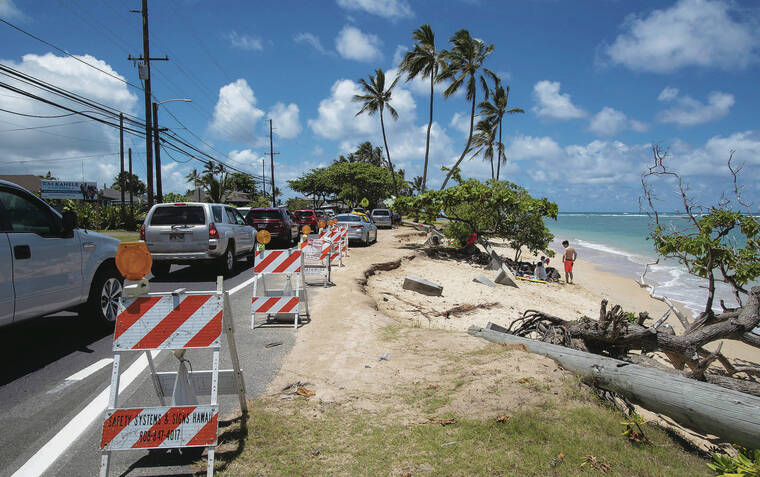The state Department of Transportation is proposing to build a 450-foot-long rock revetment along a stretch of shoreline in Kaaawa to forestall the potential collapse of a section of Kamehameha Highway.
A final environmental assessment on the $2 million project, which anticipates a finding of no significant impacts, notes the two-lane highway is the only road connecting Windward Oahu’s coastal communities and is the primary access for police, fire and emergency medical services.
The assessment, published Thursday in the state Office of Planning and Sustainability’s Environmental Notice Opens in a new tab, says the highway carries an average of 13,000 vehicles per day and in some areas closely follows the coastline within a few feet of the ocean, “and only a few feet above it in other places.” During periods of extreme high tides and surf, the ocean often washes over the highway directly across from Kaaawa Elementary School, leaving the road shoulder “dangerously undermined and cracked in many places.”
Kamehameha Highway from Kualoa to Kahuku was mentioned in DOT’s Hawai‘i Highways Climate
Adaptation Action Plan Opens in a new tab as vulnerable to coastal erosion, sea level rise, storm surges and tsunamis.
The agency’s 2019 Statewide Coastal Highway Program Report Opens in a new tab, which assessed and ranked the susceptibility of state coastal roads to erosion and structural degradation due to ocean hazards, ranked the stretch of road through Kaaawa as No. 3 on its priority list.
The No. 1 priority was a section of Kamehameha Highway in Hauula, north of Kaaawa.
The shoreline at Kaaawa was previously hardened by a mixture of temporary emergency repairs that are deteriorating and failing, the environmental assessment said, further destabilizing the shoreline and risking a collapse or partial collapse of the highway.
DOT is proposing to construct an engineered, sloping rock revetment on top of existing sand and rubble deposits on a narrow strand of sandy beach that is usually submerged at high tide. The permeable, uncemented structure would be
approximately 24 feet wide and
450 feet long, cresting at about
8 feet.
“A revetment is the preferred option because it is a longer-term solution for the protection of the critical roadway, which also minimizes reflected energy at the shoreline,” according to the assessment.
Geotextile filtercloth would be used as a base to prevent erosion and loss of underlying sediments, upon which a layer of smaller rocks would be placed. The structure would be finished with an “outer
armor layer” of larger rocks.
The study found the project “is not expected to significantly alter
or affect presently ongoing shoreline processes, wave-driven currents, circulation patterns, overall water quality, or offshore wave breaking,” and would not change sand movement
patterns.
In fact, “the porous revetment will dissipate more wave energy and be less
reflective than the existing shoreline and thus may aid in retaining sand along the shoreline, particularly during high wave conditions,” the assessment said. And since the revetment would be built almost entirely mauka of the water line, it is not expected to have any significant effects on the marine environment beyond temporary increases in turbidity during construction, according to the study.
“The paucity of corals in the area indicates it is not an ideal habitat for reef development, and the existing corals are pre-adapted to stressful conditions. The present lack of fish indicates that there is little potential for any effect on the existing populations from temporary increases in turbidity,” the assessment said.
Plans call for installing silt curtains around construction areas to contain and control potential
turbidity.
Additionally, green sea turtles are not commonly seen foraging in the nearshore waters or nesting in the area, the assessment said, and would likely avoid the construction zone.
The project still needs an Army Corps of Engineers permit, a state Conservation District use permit and other approvals. If granted, and once a contract is awarded, construction could start as soon as this fall for a period of 120 days, according to the assessment.
The Ka‘a‘awa Community Association, one of the groups consulted and a
participant in virtual public meetings on the project, expressed “strong support” for the rock revetment, saying repairs to the Kaaawa roadway are long overdue.
In a letter to DOT, association President Kealoha
Domingo also expressed community concerns that included retaining a comparable area of sandy beach and “extreme attention” to disturbance of potential burial sites and iwi, “as we have had an increased amount of naturally occurring disturbed burial sites in the past two years.”
Domingo also cited
worries about traffic
disruptions.
DOT said the project will require closure of the makai, northbound lane during construction activity, which would be limited to the hours of 8:30 a.m. to 3:30 p.m. weekdays, with no work on weekends or state holidays, or at night.
With an estimated design life of 25 years, the project is considered a short- to medium-term solution, the assessment said.
“Global climate change and sea level rise are affecting Hawaii’s coastlines — from now into the future —
and will necessitate long-term planning for the future, which may entail significant changes from current coastal land use and activities.”

